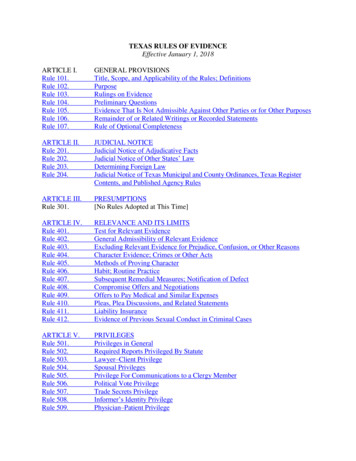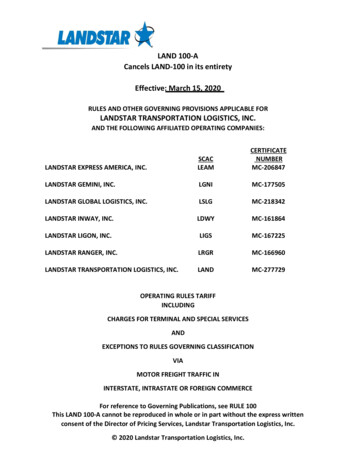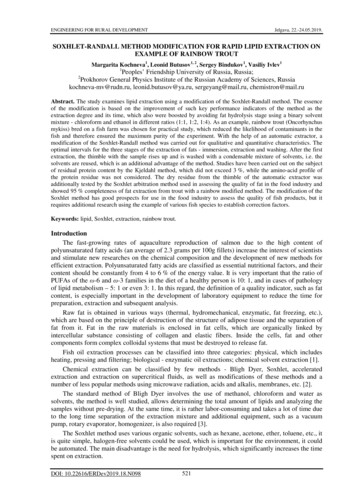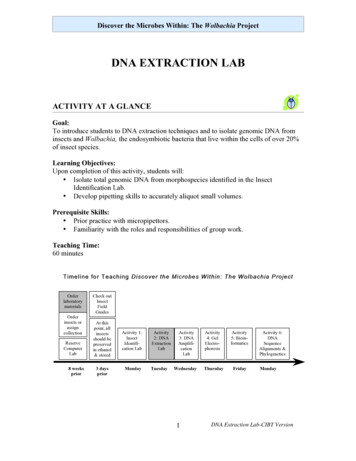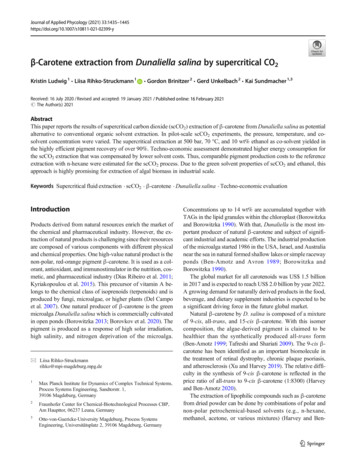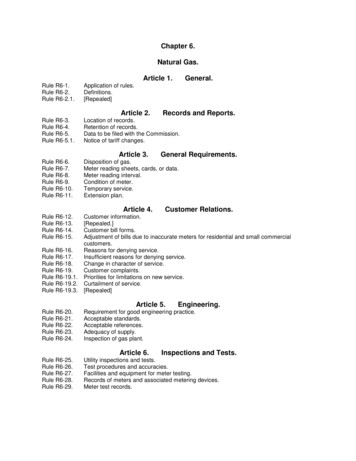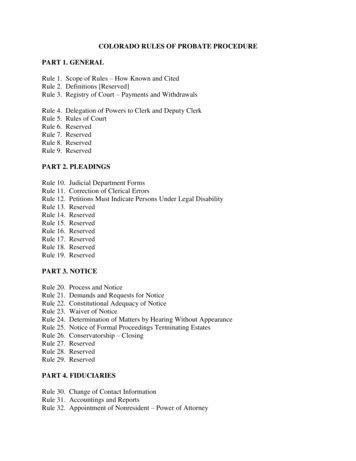
Transcription
Rule-based Information Extraction is Dead!Long Live Rule-based Information Extraction Systems!Laura ChiticariuIBM Research - AlmadenSan Jose, CAchiti@us.ibm.comYunyao LiIBM Research - AlmadenSan Jose, ty*Extrac@on*100% The rise of “Big Data” analytics over unstructured text has led to renewed interest in information extraction (IE). We surveyed the landscape of IE technologies and identified a majordisconnect between industry and academia:while rule-based IE dominates the commercialworld, it is widely regarded as dead-end technology by the academia. We believe the disconnect stems from the way in which the twocommunities measure the benefits and costs ofIE, as well as academia’s perception that rulebased IE is devoid of research challenges. Wemake a case for the importance of rule-basedIE to industry practitioners. We then lay out aresearch agenda in advancing the state-of-theart in rule-based IE systems which we believehas the potential to bridge the gap betweenacademic research and industry practice.1Frederick R. ReissIBM Research - AlmadenSan Jose, CAfrreiss@us.ibm.com3.5%*21% 45%*67%*Rule, Based 17% Hybrid 50% 75% 22% 33% 17% 0% achine Learning Based Commercial*Vendors*(2013)*Figure 1: Fraction of NLP conference papers fromEMNLP, ACL, and NAACL over 10 years that use machine learning versus rule-based techniques to performentity extraction over text (left); the same breakdown forcommercial entity extraction vendors one year after theend of this 10-year period (right). The rule-based approach, although largely ignored in the research community, dominates the commercial market.IntroductionThe recent growth of “Big Data” analytics over largequantities of unstructured text has led to increasedinterest in information extraction technologies fromboth academia and industry (Mendel, 2013).Most recent academic research in this area startsfrom the assumption that statistical machine learning is the best approach to solving information extraction problems. Figure 1 shows empirical evidence of this trend drawn from a survey of recent published research papers. We examined theEMNLP, ACL, and NAACL conference proceedingsfrom 2003 through 2012 and identified 177 differentEMNLP research papers on the topic of entity extraction. We then classified these papers into threecategories, based on the techniques used: purelyrule-based, purely machine learning-based, or a hybrid of the two. We focus on entity extraction, as itis a classical IE task, and most industrial IE systemsoffer this feature.The left side of the graph shows the breakdownof research papers according to this categorization.Only six papers relied solely on rules to perform theextraction tasks described. The remainder relied entirely or substantially on statistical techniques. Asshown in Figure 2, these fractions were roughly constant across the 10-year period studied, indicatingthat attitudes regarding the relative importance of thedifferent techniques have remained constant.We found that distinguishing “hybrid” systems827Proceedings of the 2013 Conference on Empirical Methods in Natural Language Processing, pages 827–832,Seattle, Washington, USA, 18-21 October 2013. c 2013 Association for Computational Linguistics
En@ty*Extrac@on*Papers*by*Year*Rule, Based FracAon of NLP Papers 100% Hybrid 75% Machine Learning Based 50% 25% 0% Year of PublicaAon Table 1: Vendors and products considered in the study.ai-oneAttensityBasis TechnologyClarabridgeDaedalusGATEGeneral SentimentHPIBMIBMFigure 2: The conference paper data (left-hand bar) fromFigure 1, broken down by year of publication. The relative fractions of the three different techniques have notchanged significantly over time.from pure machine learning systems was quite challenging. The papers that use a mixture of rulebased and machine learning techniques were generally written so as to obfuscate the use of rules, emphasizing the machine learning aspect of the work.Authors hid rules behind euphemisms such as “dependency restrictions” (Mausam et al., 2012), “entity type constraints” (Yao et al., 2011), or “seed dictionaries” (Putthividhya and Hu, 2011).In the commercial world, the situation is largelyreversed. The right side of Figure 1 shows the resultof a parallel survey of commercial entity extractionproducts from 54 different vendors listed in (Yuenand Koehler-Kruener, 2012). We studied analystreports and product literature, then classified eachproduct according to the same three categories. Table 1 shows the 41 products considered in the study1 . We conducted this industry survey in 2013, oneyear after the ten-year run of NLP papers we studied. One would expect the industrial landscape toreflect the research efforts of the previous 10 years,as mature technology moved from academia to industry. Instead, results of this second survey showedthe opposite effect, with rule-based systems comprising the largest fraction of those surveyed. Only1/3 of the vendors relied entirely on machine learning. Among public companies and private compa1Other products do not offer entity extraction, or we did notfind sufficient evidence to classify the technology.828IBMIntraFindIxRevealKnimeLanguage oftMotiveQuestNice SystemsOpenAmplifyOpenTextPingarProvalis martlogicSRA on ReutersVedaZyLabNathanAppCommand CenterRosetteAnalyzeStilus NERInformation ExtractionAutonomy IDOL EductionInfoSphere BigInsights TextAnalyticsInfoSphere Streams Text AnalyticsSPSS Text Analytics for SurveysiFinder NAMERuHarmonizeCicero LITESalienceLingPipeAnalytics & Business IntelligenceeZi COREFAST Search ServerNiceTrack Open Source IntelligenceInsightsContent AnalyticsWordStatText Processing ExtensionAeroTextRadian 6HANA Text AnalysisText AnalyticsSemaphore Classificationand Text Mining ServerNetOwl Text AnalyticsSTATISTICA Text MinerLuxid Content EnrichmentPlatform(integration w/ Attensity)Extract!OpenCalaisSemantics Entity IdentifierText Mining&Analytics
ML-basedRule-basedTable 2: Pros and ConsProsCons Declarative Easy to comprehend Easy to maintain Easy to incorporatedomain knowledge Easy to trace and fixthe cause of errors Heuristic Requires tediousmanual labor Trainable Adaptable Reduces manualeffort Requires labeled data Requires retrainingfor domain adaptation Requires ML expertiseto use or maintain Opaquenies with more than 100 million in revenue, the situation is even more skewed towards rule-based systems, with large vendors such as IBM, SAP, and Microsoft being completely rule-based.2Explaining the DisconnectWhat is the source of this disconnect between research and industry? There does not appear to bea lack of interaction between the two communities.Indeed, many of the smaller companies we surveyedwere founded by NLP researchers, and many of thelarger vendors actively publish in the NLP literature.We believe that the disconnect arises from a difference in how the two communities measure the costsand benefits of information extraction.Table 2 summarizes the pros and cons of machinelearning (ML) and rule-based IE technologies (Atzmueller and Kluegl, 2008; Grimes, 2011; Leung etal., 2011; Feldman and Rosenfeld, 2006; Guo etal., 2006; Krishnan et al., 2005; Yakushiji et al.,2006; Kluegl et al., 2009). On the surface, bothacademia and commercial vendors acknowledge essentially the same pros and cons for the two approaches. However, the two communities weight thepros and cons significantly differently, leading to thedrastic disconnect in Figure 1.Evaluating the benefits of IE. Academic papersevaluate IE performance in terms of precision andrecall over standard labeled data sets. This simple,clean, and objective measure is useful for judgingcompetitions, but the reality of the business world is829much more fluid and less well-defined.In a business context, definitions of even basic entities like “product” and “revenue” vary widely fromone company to another. Within any of these illdefined categories, some entities are more importantto get right than others. For example, in electroniclegal discovery, correctly identifying names of executives is much more important than finding othertypes of person names.In real-world applications, the output of extraction is often the input to a larger process, and itis the quality of the larger process that drives business value. This quality may derive from an aspectof extracted output that is only loosely correlatedwith overall precision and recall. For example, doesextracted sentiment, when broken down and aggregated by product, produce an unbiased estimate ofaverage sentiment polarity for each product?To be useful in a business context, IE must function well with metrics that are ill-defined and subject to change. ML-based IE models, which requirea careful up-front definition of the IE task, are poorfit for these metrics. The commercial world greatlyvalues rule-based IE for its interpretability, whichmakes IE programs easier to adopt, understand, debug, and maintain in the face of changing requirements (Kluegl et al., 2009; Atzmueller and Kluegl,2008). Furthermore, rule-based IE programs are valued for allowing one to easily incorporate domainknowledge, which is essential for targeting specificbusiness problems (Grimes, 2011). As an example,an application may pose simple requirements to itsentity recognition component to output only full person names, and not include salutation. With a rulebased system, such a requirement translates to removing a few rules. On the other hand, a ML-basedapproach requires a complete retrain.Evaluating the costs of IE. In a business setting,the most significant costs of using information extraction are the labor cost of developing or adaptingextractors for a particular business problem, and thehardware cost of compute resources required by thesystem.NLP researchers generally have a well-developedsense of the labor cost of writing extraction rules,viewing this task as a “tedious and time-consumingprocess” that “is not really practical” (Yakushiji etal., 2006). These criticisms are valid, and, as we
point out in the next section, they motivate a researcheffort to build better languages and tools.But there is a strong tendency in the NLP literature to ignore the complex and time-consumingtasks inherent in solving an extraction problem usingmachine learning. These tasks include: defining thebusiness problem to be solved in strict mathematicalterms; understanding the tradeoffs between differenttypes of models in the context of the NLP task definition; performing feature engineering based on asolid working understanding of the chosen model;and gathering extensive labeled data — far morethan is needed to measure precision and recall —often through clever automation.All these steps are time-consuming; even highlyqualified workers with postgraduate degrees routinely fail to execute them effectively. Not surprisingly, in industry, ML-based systems are oftendeemed risky to adopt and difficult to understandand maintain, largely due to model opaqueness (Fry,2011; Wagstaff, 2012; Malioutov and Varshney,2013). The infeasibility of gathering labeled data inmany real-world scenarios further increases the riskof committing to a ML-based solution.A measure of the system’s scalability and runtime efficiency, hardware costs are a function of twometrics: throughput and memory footprint. Thesefigures, while extremely important for commercialvendors, are typically not reported in NLP literature. Nevertheless, our experience in practice suggests that ML-based approaches are much slower,and require more memory compared to rule-basedapproaches, whose throughput can be in the orderof MB/second/core for complex extraction tasks likeNER (Chiticariu et al., 2010).The other explanation. Finally, we believe that themost notable reason behind the academic community’s steering away from rule-based IE systems isthe (false) perception of lack of research problems.The general attitude is one of “What’s the researchin rule-based IE? Just go ahead and write the rules.”as indicated by anecdotal evidence and only implicitly stated in the literature, where any usage of rulesis significantly underplayed as explained earlier. Inthe next section, we strive to debunk this perception.8303Bridging the GapAs NLP researchers who also work regularly withbusiness customers, we have become increasinglyworried about the gap in perception between information extraction research and industry. The recentgrowth of Big Data analytics has turned IE into bigbusiness (Mendel, 2013). If current trends continue,the business world will move ahead with unprincipled, ad-hoc solutions to customers’ business problems, while researchers pursue ever more complexand impractical statistical approaches that becomeincreasingly irrelevant. Eventually, the gap betweenresearch and practice will become insurmountable,an outcome in neither community’s best interest.The academic NLP community needs to stoptreating rule-based IE as a dead-end technology. Asdiscussed in Section 2, the domination of rule-basedIE systems in the industry is well-justified. Even intheir current form, with ad-hoc solutions built ontechniques from the early 1980’s, rule-based systems serve the industry needs better than the latest ML techniques. Nonetheless, there is an enormous untapped opportunity for researchers to makethe rule-based approach more principled, effective,and efficient. In the remainder of this section, welay out a research agenda centered around capturing this opportunity. Specifically, taking a systemicapproach to rule-based IE, one can identify a set ofresearch problems by separating rule developmentand deployment. In particular, we believe researchshould focus on: (a) data models and rule language,(b) systems research in rule evaluation and (c) machine learning research for learning problems in thisricher target language.Define standard IE rule language and datamodel. If research on rule-based IE is to moveforward in a principled way, the community needsa standard way to express rules. We believe thatthe NLP community can replicate the success ofthe SQL language in connecting data managementresearch and practice. SQL has been successfullargely due to: (1) expressivity: the language provides all primitives required for performing basicmanipulation of structured data, (2) extensibility: thelanguage can be extended with new features withoutfundamental changes to the language, (3) declarativity: the language allows the specification of com-
putation logic without describing its control flow,thus allowing developers to code what the programshould accomplish, rather than how to accomplish it.An earlier attempt in late 1980’s to formalize a rule language resulted in the Common Pattern Specification Language (CPSL) (Appelt andOnyshkevych, 1998). While CPSL did not succeed due to multiple drawbacks, including expressivity limitations, performance limitations, and itslack of support for core operations such as part ofspeech (Chiticariu et al., 2010), CPSL did gain sometraction, e.g., it powers the JAPE language of theGATE open-source NLP system (Cunningham et al.,2011). Meanwhile, a number of declarative IE languages developed in the database community, including AQL (Chiticariu et al., 2010; Li et al., 2011),xLog (Shen et al., 2007), and SQL extensions (Wanget al., 2010; Jain et al., 2009), have shown that formalisms of rule-based IE systems are possible, asexemplified by (Fagin et al., 2013). However, theylargely remain unknown in the NLP community.We believe now is the right time to establish astandard IE rule language, drawing from existingproposals and experience over the past 30 years. Towards this goal, IE researchers need to answer thefollowing questions: What is the right data model tocapture text, annotations over text, and their properties? Can we establish a standard declarative extensible rule language for processing data in this modelwith a clear set of constructs that is sufficiently expressive to solve most IE tasks encountered so far?Systems research based on standard IE rule language. Standard IE data model and language enables the development of systems implementing thestandard. One may again wonder, “Where is the research in that?” As in the database community, initial research should focus on systemic issues suchas data representation and speeding up rule evaluation via automatic performance optimization. Oncebaseline systems are established, system-related research would naturally diverge in several directions,such as extending the language with new primitives(and corresponding optimizations), and exploringmodern hardware.ML research based on standard IE rule language.A standard rule language and corresponding execution engine enables researchers to use the standardlanguage as the expressivity of the output model,831and define learning problems for this target language, including learning basic primitives such asregular expressions and dictionaries, or completerule sets. (One need not worry about choosing thelanguage, nor runtime efficiency.) With an expressive rule language, a major challenge is to preventthe system from generating arbitrarily complex rulesets, which would be difficult to understand or maintain. Some interesting research directions includedevising proper measures for rule complexity, constraining the search space such that the learnt rulesclosely resemble those written by humans, activelearning techniques to cope with scarcity of labeleddata, and visualization tools to assist rule developers in exploring and choosing between different automatically generated rules. Finally, it is conceivable that some problems will not fit in the targetlanguage, and therefore will need alternative solutions. However, the community would have shown– objectively – that the problem is not learnablewith the available set of constructs, thus motivatingfollow-on research on extending the standard withnew primitives, if possible, or developing novel hybrid IE solutions by leveraging the standard IE rulelanguage together with ML technology.4ConclusionWhile rule-based IE dominates the commercialworld, it is widely considered obsolete by theacademia. We made a case for the importanceof rule-based approaches to industry practitioners.Drawing inspiration from the success of SQL andthe database community, we proposed directionsfor addressing the disconnect. Specifically, we callfor the standardization of an IE rule language andoutline an ambitious research agenda for NLP researchers who wish to tackle research problems ofwide interest and value in the industry.AcknowledgmentsWe would like to thank our colleagues, HowardHo, Rajasekar Krishnamurthy, and ShivakumarVaithyanathan, as well as the anonymous reviewersfor their thoughtful and constructive comments.
ReferencesDouglas E. Appelt and Boyan Onyshkevych. 1998. TheCommon Pattern Specification Language. In Proceedings of a workshop held at Baltimore, Maryland: October 13-15, 1998, TIPSTER ’98, pages 23–30.Martin Atzmueller and Peter Kluegl. 2008. Rule-BasedInformation Extraction for Structured Data Acquisition using TextMarker. In LWA.Laura Chiticariu, Rajasekar Krishnamurthy, Yunyao Li,Sriram Raghavan, Frederick Reiss, and ShivakumarVaithyanathan. 2010. SystemT: An Algebraic Approach to Declarative Information Extraction. In ACL.Hamish Cunningham, Diana Maynard, KalinaBontcheva, Valentin Tablan, Niraj Aswani, IanRoberts, Genevieve Gorrell, Adam Funk, Angus Roberts, Danica Damljanovic, Thomas Heitz,Mark A. Greenwood, Horacio Saggion, JohannPetrak, Yaoyong Li, and Wim Peters. 2011. TextProcessing with GATE (Version 6), Chapter 8: JAPE:Regular Expressions over Annotations.Ronald Fagin, Benny Kimelfeld, Frederick Reiss, andStijn Vansummeren. 2013. Spanners: a formal framework for information extraction. In PODS.Ronen Feldman and Benjamin Rosenfeld. 2006. Boosting Unsupervised Relation Extraction by Using NER.In EMNLP, pages 473–481.C. Fry. 2011. Closing the Gap between Analytics andAction. INFORMS Analytics Mag., 4(6):405.Seth Grimes.2011.Text/Content Analytics 2011:User Perspectives on ext-analytics-market-study/ .Hong Lei Guo, Li Zhang, and Zhong Su. 2006.Empirical study on the performance stability ofnamed entity recognition model across domains.In EMNLP, pages 509–516.Alpa Jain, Panagiotis Ipeirotis, and Luis Gravano.2009. Building query optimizers for informationextraction: the sqout project. SIGMOD Record,37(4):28–34.Peter Kluegl, Martin Atzmueller, and Frank Puppe.2009. TextMarker: A Tool for Rule-Based Information Extraction. In UIMA@GSCL Workshop,pages 233–240.Vijay Krishnan, Sujatha Das, and SoumenChakrabarti. 2005. Enhanced answer typeinference from questions using sequential models. In HLT, pages 315–322.Cane Wing-ki Leung, Jing Jiang, Kian Ming A.Chai, Hai Leong Chieu, and Loo-Nin Teow.8322011. Unsupervised Information Extraction withDistributional Prior Knowledge. In EMNLP,pages 814–824.Yunyao Li, Frederick Reiss, and Laura Chiticariu.2011. Systemt: A declarative information extraction system. In ACL.Dmitry M. Malioutov and Kush R. Varshney. 2013.Exact rule learning via boolean compressed sensing. In ICML.Mausam, Michael Schmitz, Stephen Soderland,Robert Bart, and Oren Etzioni. 2012. Open Language Learning for Information Extraction. InEMNLP-CoNLL, pages 523–534.Thomas e-and-Big-Data-Trends-2013(accessed March 28th, 2013).Duangmanee Putthividhya and Junling Hu. 2011.Bootstrapped Named Entity Recognition forProduct Attribute Extraction. In EMNLP, pages1557–1567.Warren Shen, AnHai Doan, Jeffrey F. Naughton, andRaghu Ramakrishnan. 2007. Declarative Information Extraction Using Datalog with EmbeddedExtraction Predicates. In VLDB, pages 1033–1044.Kiri Wagstaff. 2012. Machine learning that matters.In ICML.Daisy Zhe Wang, Eirinaios Michelakis, Michael J.Franklin, Minos N. Garofalakis, and Joseph M.Hellerstein. 2010. Probabilistic Declarative Information Extraction. In ICDE.Akane Yakushiji, Yusuke Miyao, Tomoko Ohta,Yuka Tateisi, and Jun’ichi Tsujii. 2006. Automatic construction of predicate-argument structure patterns for biomedical information extraction. In EMNLP, pages 284–292.Limin Yao, Aria Haghighi, Sebastian Riedel, andAndrew McCallum. 2011. Structured RelationDiscovery using Generative Models. In EMNLP,pages 1456–1466.Daniel Yuen and Hanns Koehler-Kruener. 2012.Who’s Who in Text Analytics, September.
IBM InfoSphere Streams Text An-alytics IBM SPSS Text Analytics for Sur-veys IntraFind iFinder NAMER IxReveal uHarmonize Knime Language Computer Cicero LITE Lexanalytics Salience . ZyLab Text Mining&Analytics 828. Table 2: Pros and Cons Pros Cons Rule-based Declarative Heuristic Easy to comprehend Requires tedious Easy to maintain manual labor
